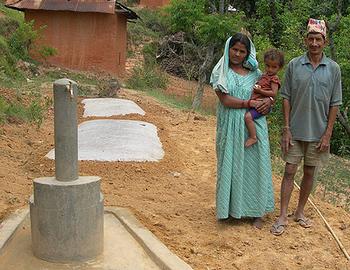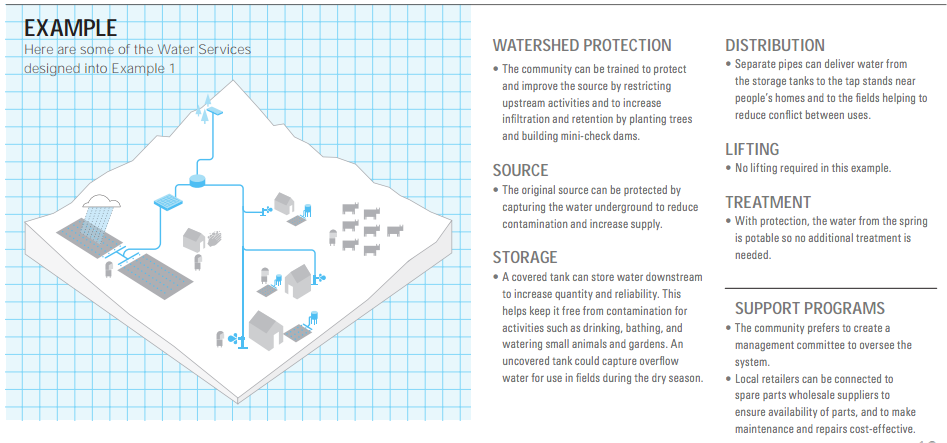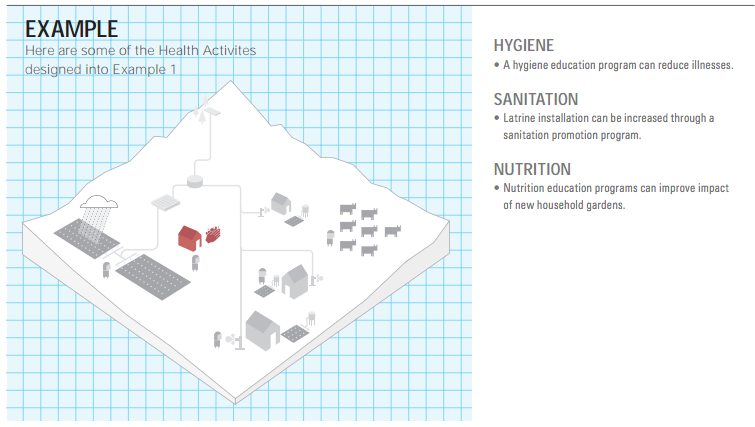Difference between revisions of "Water Portal / Rainwater Harvesting / Multiple Use Services (MUS)"
(→What does a multiple-use water service look like?) |
|||
| Line 19: | Line 19: | ||
Once you understand the people, their needs and desires, and the sources, you can design an integrated water service with supporting health and livelihood components. How do you decide on the right combination of technologies and supporting programs? | Once you understand the people, their needs and desires, and the sources, you can design an integrated water service with supporting health and livelihood components. How do you decide on the right combination of technologies and supporting programs? | ||
| − | 1. Multiple-use water services are not about just repeating the same technology throughout a community. Choosing the right technology can be an | + | '''1. Water:''' Multiple-use water services are not about just repeating the same technology throughout a community. Choosing the right technology can be an |
important part of creating a successful and sustainable service by enabling a community to use the right technology for the right uses. Equally important is choosing the right supporting programs (governance, management, and training), that will enable long-term sustainability of the water services. | important part of creating a successful and sustainable service by enabling a community to use the right technology for the right uses. Equally important is choosing the right supporting programs (governance, management, and training), that will enable long-term sustainability of the water services. | ||
| − | [[File: MUS water chart.png|thumb|none|500px|Chart: [http://www.rockefellerfoundation.org/uploads/files/6017a66b-db64-46ca-97ff-2db8e873cc04.pdf Winrock International]]] | + | [[File: MUS water chart.png|thumb|none|500px|Click to zoom. Chart: [http://www.rockefellerfoundation.org/uploads/files/6017a66b-db64-46ca-97ff-2db8e873cc04.pdf Winrock International]]] |
A key element of support programs is management. Work with water users to design a management structure that takes into account their resources and constraints. Some options for a management structure are community (management by committee or delegation to an entrepreneur or enterprise) or private (management by individual, household, or small group). | A key element of support programs is management. Work with water users to design a management structure that takes into account their resources and constraints. Some options for a management structure are community (management by committee or delegation to an entrepreneur or enterprise) or private (management by individual, household, or small group). | ||
| − | 2. By only providing potable water, you can make a health impact. To the extent that project resources permit, designing additional Health Activities (hygiene, sanitation, and nutrition) can maximize the overall health impacts of the new water service. Information learned in the Assessment process along with the results from the Design of Water Services can inform which Health Activities to include in the project. | + | '''2. Health:''' By only providing potable water, you can make a health impact. To the extent that project resources permit, designing additional Health Activities (hygiene, sanitation, and nutrition) can maximize the overall health impacts of the new water service. Information learned in the Assessment process along with the results from the Design of Water Services can inform which Health Activities to include in the project. |
| − | [[File: MUS health chart.png|thumb|none|500px|Chart: [http://www.rockefellerfoundation.org/uploads/files/6017a66b-db64-46ca-97ff-2db8e873cc04.pdf Winrock International]]] | + | [[File: MUS health chart.png|thumb|none|500px|Click to zoom. Chart: [http://www.rockefellerfoundation.org/uploads/files/6017a66b-db64-46ca-97ff-2db8e873cc04.pdf Winrock International]]] |
| − | 3. Simply by providing holistic water services, livelihoods will be improved. To the extent that project resources permit, designing additional | + | '''3. Livelihoods:''' Simply by providing holistic water services, livelihoods will be improved. To the extent that project resources permit, designing additional Livelihoods Activities (agriculture, livestock, trade) can broaden the impact of your project by increasing incomes and enabling access to |
| − | Livelihoods Activities (agriculture, livestock, trade) can broaden the impact of your project by increasing incomes and enabling access to | ||
opportunities like education. | opportunities like education. | ||
| − | [[File: MUS livelihoods chart.png|thumb|none|500px|Chart: [http://www.rockefellerfoundation.org/uploads/files/6017a66b-db64-46ca-97ff-2db8e873cc04.pdf Winrock International]]] | + | [[File: MUS livelihoods chart.png|thumb|none|500px|Click to zoom. Chart: [http://www.rockefellerfoundation.org/uploads/files/6017a66b-db64-46ca-97ff-2db8e873cc04.pdf Winrock International]]] |
==Manuals, videos and links== | ==Manuals, videos and links== | ||
Revision as of 06:57, 3 September 2013

Multiple-use water services (MUS) is an innovative approach to water services. It unlocks new investment opportunities for poverty reduction and gender equity in peri-urban and rural areas. MUS takes people’s multiple water needs as the starting point of planning and design of new systems and upgrades. Universally, water users already use ‘domestic’ systems or ‘irrigation’ systems for multiple purposes, whether legal or not. By planning for these multiple uses, many more benefits from investments in infrastructure can be realized: health, freedom from domestic chores, food and income and gender equity.
Multiple-use water services is a holistic approach to
sustainable water services that improves health and livelihoods.

Homestead-scale MUS: 50 – 200 litres per capita per day
Whenever water is available near homes and on adjoining lands, or ‘homesteads’, people use such water for domestic and many productive uses. This empirical relationship between water uses and availability is depicted in the ‘multiple-use water ladder’. The policy recommendation is to enable poor people ‘to climb the water ladder’ and to provide 50-200 liters per capita per day. Out of this, 3-5 liters per capita per day should be safe for drinking. Income generated enable repayment of most multiple-use systems investments within three years. Homestead-scale MUS is especially beneficial for women, who are disproportionately responsible for domestic water supplies and tend to have a stronger say over homestead production. The land-poor, who only have access to homestead land, also benefit.
Community-scale MUS: local-level integrated water resource management
Here MUS takes communities as entry point of water services. It holistically considers their multiple water uses (domestic, irrigation, animal watering, tree-growing, fisheries, enterprises, ceremonies, environment) from multiple water sources (rain, surface water, groundwater, wetlands) at multiple sites (homesteads, fields, open access). This integrated water resource management at the local level is (potentially) considerably more cost-effective and sustainable than single-use water services.
What does a multiple-use water service look like?
Once you understand the people, their needs and desires, and the sources, you can design an integrated water service with supporting health and livelihood components. How do you decide on the right combination of technologies and supporting programs?
1. Water: Multiple-use water services are not about just repeating the same technology throughout a community. Choosing the right technology can be an important part of creating a successful and sustainable service by enabling a community to use the right technology for the right uses. Equally important is choosing the right supporting programs (governance, management, and training), that will enable long-term sustainability of the water services.

A key element of support programs is management. Work with water users to design a management structure that takes into account their resources and constraints. Some options for a management structure are community (management by committee or delegation to an entrepreneur or enterprise) or private (management by individual, household, or small group).
2. Health: By only providing potable water, you can make a health impact. To the extent that project resources permit, designing additional Health Activities (hygiene, sanitation, and nutrition) can maximize the overall health impacts of the new water service. Information learned in the Assessment process along with the results from the Design of Water Services can inform which Health Activities to include in the project.

3. Livelihoods: Simply by providing holistic water services, livelihoods will be improved. To the extent that project resources permit, designing additional Livelihoods Activities (agriculture, livestock, trade) can broaden the impact of your project by increasing incomes and enabling access to opportunities like education.

Manuals, videos and links
- PDF: A Guide to Multiple-Use Water Services. Winrock International.
Water System (MUS) Program
Acknowledgements
- Models For Implementing Multiple-Use Water Supply Systems For Enhanced Land And Water Productivity, Rural Livelihoods And Gender Equity – Multiple Use Systems (MUS). Ongoing research - CIGAR.
